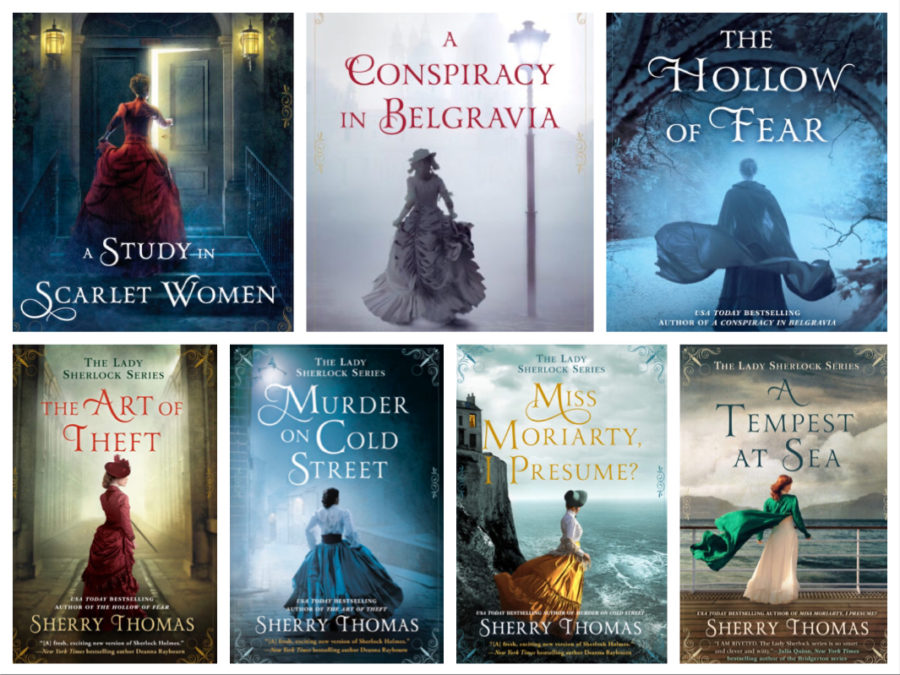Review: ‘Lady Sherlock’ series investigates gender roles in Sherlockian adaptations
Courtesy of ladysherlockbooks.com
The “Lady Sherlock” series is a gender-flipped retelling of Sherlock Holmes that features Charlotte Holmes, a young woman with unique talents for observation and deduction. Book seven of the series, “A Tempest at Sea,” will be released on March 14.
Everyone knows the name Sherlock Holmes, the great detective with unmatched deduction skills. But readers might be surprised as they pick up the “Lady Sherlock” series, a gender-flipped retelling that brings unexpected twists to the classic tales of Holmes.
Written by Chinese-born American author Sherry Thomas, the series follows the adventures of Charlotte Holmes, a young woman with unique talents for observation and logical reasoning. Often feeling restrained by the societal norms of Victorian England, Charlotte escapes from home and uses her mental acuity to solve crimes, posing as the sister of the nonexistent “Sherlock Holmes, consulting detective.”
Readers both new to Sherlock Holmes canon and fans of the original stories can find themselves enjoying the “Lady Sherlock” series, as Thomas strikes a perfect balance between her adaptation and the classic. While reading the series, readers will find characters both new and familiar, such as Watson (in this case, Mrs. Joanna Watson, wife to the late Dr. John Watson and benefactor to Charlotte Holmes), Moriarty and the inspectors from Scotland Yard. Additionally, Thomas’s retelling also pays tribute to the initial story by Sir Arthur Conan Doyle amidst her original storylines. For example, book one of the series, “A Study in Scarlet Women,” is based on “A Study in Scarlet,” the first of the Sherlock Holmes novels, and the plot of book two, “A Conspiracy in Belgravia,” parallels that of “A Scandal in Bohemia.”
While predominantly a romance writer, Thomas skillfully weaves suspense into her first major mystery attempt. She achieves tension through switching between viewpoints of different characters and cutting off a trail of clues just before further explaining its significance, so that readers are propelled to form their own speculations regarding the plot. Still, Thomas plants a romance storyline throughout the series. Although Charlotte Holmes falls under the aloof, logical type, she also holds feelings for Lord Ingram Ashburton, her ally in investigation who has been secretly in love with her since childhood. As the relationship between the two evolves, readers get to experience a different type of tension other than suspense.
One major highlight of the series is how Thomas presents the theme of gender equality, which makes her adaptation on Sherlock Holmes more thought-provoking. Despite being gifted with a brilliant mind, Charlotte Holmes is still a woman confined by the societal rules of Victorian England, thus forced to remain behind the scenes and attributing all her success as a consulting detective to the nonexistent Sherlock Holmes. Like Thomas has shared in an interview with NBC news, as a man, Sherlock Holmes has the luxury of not thinking about such rules, whereas as a woman, Charlotte Holmes must find a way to cope with the challenges they pose.
Regardless, Charlotte continues to challenge social norms by persevering through her investigative career, eventually earning the respect of not only her allies, but also her opponents. Similarly, Thomas creates a line of female characters who each aim to shatter societal restraints in their own ways, such as Mrs. Watson, who has been financially independent since her youth. Another example is Livia, Charlotte’s timid sister, who learns to find her voice through writing Sherlock Holmes novels based on Charlotte’s adventures.
Book seven of the “Lady Sherlock” series, “A Tempest at Sea,” will be released on March 14. Picking up from the end of book six, this latest addition of the series features Charlotte Holmes recovering a dossier sought by the crown on a royal ship. Preorders are available on multiple platforms through ladysherlockbooks.com.
Your donation will support the student journalists of Chantilly High School. Your contribution will allow us to cover our printing and annual website hosting costs.

Sixuan Wu is a senior and the Online Editor of The Purple Tide. As a 1.5 generation immigrant, she enjoys learning about different cultural experiences....









